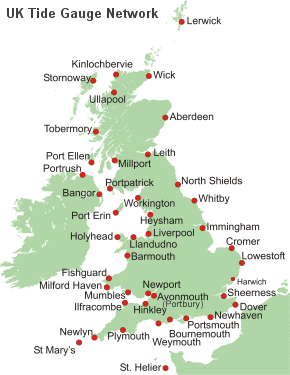Tide gauge
A tide gauge is an instrument that measures the vertical movement of the sea surface. Until the early 19th Century, sea-level measurements were made using tide poles or staffs. These still form part of modern-day tide gauge instrumentation, but have not been used as a primary source of sea-level information since the introduction of self-recording tide gauges. The earliest form of self-recording tide gauges were mechanical float and stilling well gauges. These were introduced in the UK during the 1830s. By the end of the 19th century they had been installed at most major ports around the world. They were the primary means of sea-level measurement for over 150 years and continue to operate at some UK locations today. However, they are generally auxiliary systems to newer pressure gauges. Tide gauge technology has advanced considerably over the last few decades and nowadays, many countries have adopted acoustic gauges or radar gauges as their standard means of sea-level measurement.
In order to measure long term sea level changes accurately, it is important to ensure that tide gauge instrumentation remains stable over time. This process is known as datum control and historically, it has been achieved by careful monitoring of tide gauge elevation relative to local benchmarks and datums. More recently, researchers from the National Oceanographic Centre have developed additional instrumentation to do this, known as mid-tide sensors.
SurgeWatch uses sea level records from the UK National Tide Gauge Network, available from the British Oceanographic Data Centre (BODC). This network consists of 43 operational tide gauges (Figure 1), and was set up as a result of the severe flooding in 1953. It is owned by the Environment Agency and maintained by the Tide Gauge Inspectorate at the National Oceanography Centre (NOC). UK National Tide Gauge Network underpins the UK Coastal Monitoring and Forecasting (UKCMF) Service. The NOC Tide Gauge Inspectorate examines and levels (to link to vertical benchmarks) each tide gauge annually and responds rapidly to any mechanical problems, ensuring limited data outage. The BODC has responsibility for the remote monitoring, retrieval, quality control and archive of data. They carry out daily remote checks on the performance of the gauges. Data are downloaded weekly and are quality controlled and archived centrally to provide long time series of reliable and accurate water levels for scientific and practical use.

Figure 1: The UK National Tide Gauge Network.
